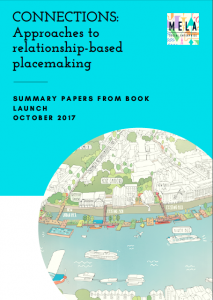
Please click on the pdf to read the Connections Report.
Connections – summary report 2017
On 31 October 2017, MELA launched its book called Connections: 12 Approaches to relationship-based placemaking. Three major themes ran through the chapters which were explored in more depth at the Connections book launch with guests.
The first theme was building trust – the critical ingredient for people to engage with each other to shape a shared future, and for professionals to support community-led placemaking initiatives that will be much more sustainable long term.
The second theme was designing in places with complex and diverse identities – in a globalised world with large scale immigration, places are no longer homogeneous. Places have become complex with competing identities which make a place interesting, but at the same time can exclude some groups from feeling they belong. Placemakers, whether they are professionals or local communities require the awareness to make places feel like everyone belongs when they design those spaces of encounter and meeting.
The third theme was bridging communities – a new desired outcome for those placemakers that engage with communities in diverse areas. Bridging communities marks a shift from consultation and engagement with those with the confidence, education and capacity to express their views, to another model in which the placemaker is the facilitator of community-building across societal divides to reach a more equitable and inclusive place.
In exploring the above themes, the concept of ‘placemaker’ is fluid – it is not only professional or institutional placemakers who have been educated and trained to plan, design and manage places, but it includes all those who use a place, whose daily behaviours make the place what it is, and whose presence (whether transient or permanent) change the place continually.
The Connections Summary Report identifies a number of recommendations.
To build trust:
- Trust has to be enabled, either through policy, an institutional ethos, or a neighbourhood initiative
- We need greater transparency and dialogue about our different values and where is our common ground
- Institutional Placemakers need to engage with leaders of communities
- Creativity is a builder of trust but should not be a one-off intervention at the start of the project but should be maintained throughout the lifespan of urban development.
- Professional education requires new skills sets for a diverse and complex world starting with empathy, listening, respect, and sensitive engagement.
- There is a role for social media in community-building, but nothing can replace face-to-face meetings and encounters
To design for complex and diverse place identities:
- Placemakers would benefit from non-rational approaches to understanding places even though they may not be measurable, they do have value
- Non-western traditions (that reflect the diverse and complex makeup of cities and societies) can offer placemakers new ways of designing harmonious and balanced places
- More room for experimentation, creativity and curiosity through temporary uses, meanwhile spaces, and pop-up spaces can provide sense of ownership and testable inclusive designs
- Use of online platforms to make radically transparent the many voices about place to counter mainstream narratives about place
- Local Authorities to promote community-led financing of neighbourhood-based initiatives
- Arts organisations are an important part of the social infrastructure of a place and can be an advocate and facilitator for urban and social development and regeneration.
To bridge between communities:
- Maintaining a balanced place requires making a place affordable through mechanisms such as lower business rates and genuinely affordable rents
- Charrettes, Learning Journeys, and participatory mapping are some ways of building a shared language between institutional placemakers and young people through face-to-face encounters
- Every place needs a community heart to bring people together
- Community centres and high streets are critical bits of social infrastructure to build relationships and intergenerational activities
